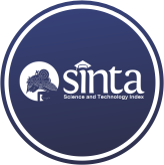Perbandingan Algoritma Naïve Bayes Dan K-Nearest Neighbor pada Analisis Sentimen Pembukaan Pariwisata Di Masa Pandemi Covid 19
(1) Universitas Nasional, Indonesia
(2) Universitas Nasional, Indonesia
(3) Universitas Nasional, Indonesia
(*) Corresponding Author
Abstract
Full Text:
PDFReferences
Satuan Tugas Penanganan., 2013. “Data Covid Indonesia.” https://covid19.go.id/.
Mochmamad Haldi Widianto, “Algoritma Naïve Bayes” https://binus.ac.id/bandung/2019/12/algoritma-naive-bayes/.
R. P. Fitrianti, A. Kurniawati, and D. Agusten, “Analisis Sentimen Terhadap Review Restoran Dengan Teks Bahasa Indonesia Menggunakan Algoritma K-Nearest Neighbor,” Semin. Nas. Apl. Teknol. Inf., pp. 27–32,2019.
Efendi, Rizal Maulana Yusuf dkk. “Sistem pakar diagnosa kerusakan VGA dengan metode certainty factor dan algoritma K-Nearest Neighbor (KNN)”.2021
Efendi, Rizal Maulana Yusuf dkk. “Visualisasi dan analisa data penyebaran covid-19 dengan metode klasifikasi naïve bayes”.2021
F. Z. Tala, "A Study of Stemming Effects on Information Retrieval in Bahasa Indonesia," Institute for Logic, Language and Computation Universeit Van Amsterdam, 2003
B. Nazief and M. Adriani, "Stemming Indonesian: A confix-stripping approach'," ACM Transactions on Asian Language Information Processing, 2007
J. Asian, H. E. Williams and S. M. M. Tahaghohi, "Stemming Indonesian," in In Conferences in Research and Practice in Information Technology Series, 2005.
R.Sari, “Analisis Sentimen pada Review Objek Wisata Dunia Fantasi Menggunakan Algoritma K Nearest Neighbor (K-Nn),” EVOLUSI J. Sains dan Manaj.,Vol. 8,No. 1,pp. 10–17, 2020, doi: 10.31294/evolusi.v8i1.7371
R. N. Safitri, “Analisis Sentimen Review Pelanggan Hotel Menggunakan Metode K-Nearest Neighbor (K-NN) (Studi Kasus: Hotels.com, Booking.com, Agoda.com),”Tugas Akhir Univ. Din.,Vol. 21,No. 1, pp. 1–9, 2020, [Online]. Available: http://repositorio.unan.edu.ni/2986/1/5624.pdf.
DOI: http://dx.doi.org/10.30645/j-sakti.v7i1.590
Refbacks
- There are currently no refbacks.
J-SAKTI (Jurnal Sains Komputer & Informatika)
Published Papers Indexed/Abstracted By:
Jumlah Kunjungan :











